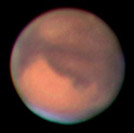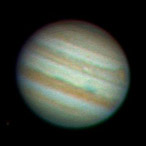|
Nb
of visitors since 02/14/2009 : 436191
Nb
of visitors today : 58
Nb
of connected : 3
Website News: |
Planetary ImagingOf the 8 planets of our solar system, only 3 are usually photographed by amateur astronomers: Mars, Jupiter and Saturn. One must be patient while photographing Mars because that planet is "close" to the Earth for only 4 months every 2 years, when Mars is at or near opposition. Outside this period, its small size and great distance make details very hard to detect with an amateur telescope. At opposition, Mars reveals its polar cap, its geological structures and its dust storms, a fascinating spectacle for anyone passionate about astronomy! Jupiter is the largest planet in the solar system. It's also the easiest to photograph, even with a modest telescope. Its annual oppositions allow observations of the movements of its 4 major satellites around the globe and of the many cloud belts and bands, storms, and cyclones which disturb the atmosphere of this gaseous planet. Saturn is the "star" planet of our solar system thanks to its system of rings that are featured in many books on astronomy. These are easily visible in small amateur instruments of various designs. In addition to the discrete cloud bands on the planet, it is possible to occasionally photograph storms located on the globe of Saturn.
Below are images of the planets captured with my 10" telescope. The category "Miscellaneous" shows pictures of other planets in our solar system, eclipses of the sun, and more. Click on the preview images below to display the corresponding pages.
|
|
|
| The discovery of the planet Neptune was a triumph of mathematics. While studying the orbit of the planet Uranus, Urbain Leverrier realized that its perturbations suggested the presence of an unknown planet in an orbit beyond that of Uranus. Leverrier promptly calculated where the planet should be found. On September 23, 1846, the astronomer Johann Galle (in Berlin) looked at the indicated spot - and discovered Neptune in less than an hour. |
|
|
|
|


.jpg)


